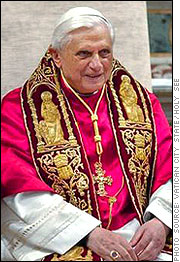Choosing a Pope

Learn how a new pope is selected upon the death or retirement of a sitting pontiff

Related Links |
It is a system that has been in place for centuries. When a pope dies, the camerlengo, or chamberlain, who is the cardinal representative from the Sacred College, takes charge and executes a particular sequence of rituals that begin with a silver mallet and a ceremonial tapping of the papal forehead and continue through a nine-day period of mourning.
Historically, this mourning period allowed non-local cardinals the time to assemble for conclave. From the Latin cum clave "with key," the conclave is a secret meeting of the cardinals formed for the express purpose of electing a new leader. The College of Cardinals must meet in conclave no sooner than 15 and no later than 20 days after a pope's death.
But what if the pope hasn't died?
In the case of Benedict XVI, who announced he would step down from the papacy on Feb. 28, 2013, obviously the mourning period can be put aside, but without the established rituals, what's to be done?
While not unprecedented, the resignation of a pope is quite unusual. Code of Canon Law does allow for it: "If it happens that the Roman Pontiff resigns his office, it is required for validity that the resignation is made freely and properly manifested but not that it is accepted by anyoneb; but does not have a system in place to orchestrate the departure-by-decision of one pope and the election of his successor. The last pope to resign was Gregory XII, who turned in his ring in 1415 as part of the agreement to end the Great Western Schism. Understandably, the Church has had other things to worry about in the last 600 years.
Scrutiny and Smoke
The community of the faithful will look to the conclave system that has been in its present state since the end of the 13th century when, according to the Concise Encyclopedia (via Merriam-Webster), "after the death of Clement IV (1268), the cardinals dithered for more than two years, the local magistrate locked them in the Episcopal palace and fed them only bread and water until they elected Gregory X." Since 1878, the kitchen is a part of the conclave, which is housed in numerous rooms in the Vatican palace and is still conducted under the strictest secrecy and seclusion. All cardinals under 80 are eligible to vote; the current cardinal count is 118, but birthdays might impact this number. The usual form of ballot is that of scrutinium, or secret ballot, and in it the successful candidate requires a two-thirds vote, not counting his own. The first ballot is held on the first afternoon of the conclave, with two voting sessions in the morning and two in the afternoon on subsequent days until a new pope is chosen.
When ready to vote the cardinals enter the Sistine Chapel, prayers are said, ballots are distributed, and the door is locked. After each vote, the ballots are burned; historically, straw was added to unsuccessful ballots to produce the black smoke which means, "no pope." Today, additives ensure the proper smoke color: white for yes, black for no. Since 2005, bells are also rung to hail a new pontiff.
When that day comes, it will mark a first in the modern era: we will have both a pope and a "former pope." Change is hard. No one knows that better than Joseph Aloisius Ratzinger. Becoming Benedict XVI at 78 was a challenge he undertook as part of his vow to serve his Church and his God. Some say it was in direct conflict with his personality. But most agree he shouldered the burden—an admittedly arduous job—with grace. Known for his humility, the oldest man to become pope in almost 300 years personified the dichotomy of ancient faith encountering the modern age, announcing his resignation in a dead language (Latin) after having tweeted via @pontifex this message only the day before: "We must trust in the mighty power of God's mercy. We are all sinners, but His grace transforms us and makes us new."







